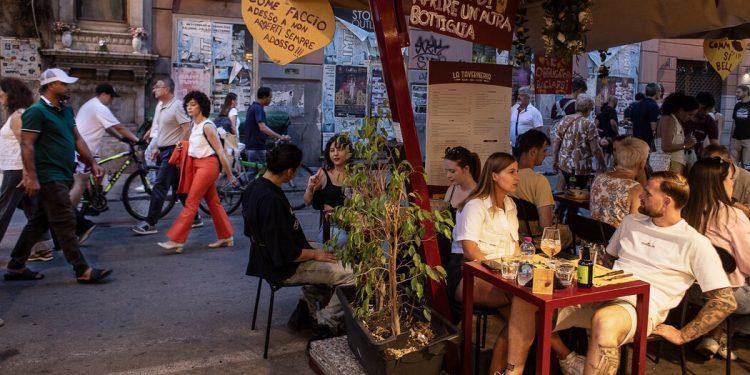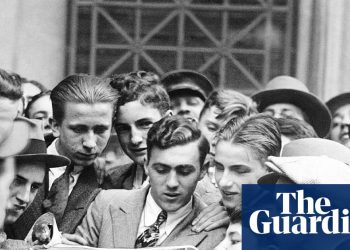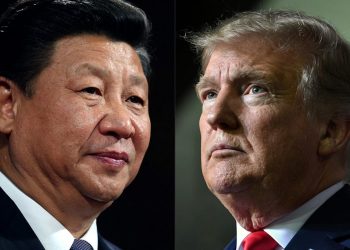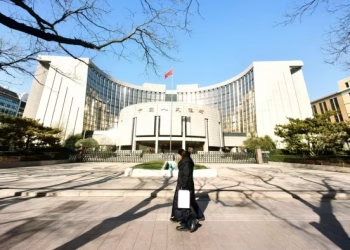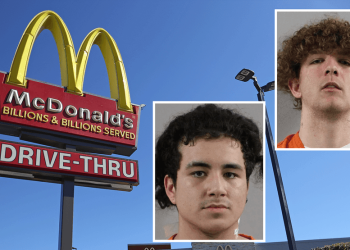There seemed to be endless Italian specialties. Fried arancine rice balls, cannoli and fluorescent Aperol spritz spilled onto the red and green checkered tablecloths of 31 crowded restaurants on a single street in Palermo, feeding a polyglot and ecstatic crowd.
“This stretch here is beautiful, it’s… bang! Restaurant after restaurant,” said Mark Smith, 55, an Australian tourist as he sipped an Aperol spritz on the street, Via Maqueda.
For the mayor of Palermo, it was one spritz too many. He banned new restaurants from opening on Via Maqueda and surrounding streets this year, recognizing that even the holy grail of Italian food had reached saturation point.
“Too much sugar spoils the coffee,” said Mayor Roberto Lagalla, chewing occasionally on an unlit cigar during an interview in a palace in the historic center of Palermo, Sicily’s capital. The center of Palermo “must not turn into a gastronomic village,” he said.
Although Italians are ardent fans of their national cuisine, many now fear it will invade their city centers, drowning out local shops and daily life in favor of tourism. In Bologna, Florence, Rome and Turin, streets have been transformed into what critics say are endless open-air restaurants serving carbonara from Instagrammable pans while women unfurl tagliatelle behind glass cases, in zoo-like simulations of Italian grandmothers.
The Italians’ concerns are not simply an affront to tourists or an aesthetic quibble, but a problem that authorities take seriously. Florence authorities also banned the opening of new restaurants in more than 50 streets. While food is central to Italy’s identity and economy, some officials and residents fear that too much food could undermine the very authenticity it celebrates, transforming parts of Italy into a caricatured, anachronistic version of itself.
“It’s an amusement park, not a city,” Karen Basile, a social worker and Palermo resident, said of Via Maqueda.
Over the past decade, increased tourism has transformed the historic centers of Italian cities. Some have become more lively and more multicultural. Some began to hollow themselves out from the inside. Central Rome has lost more than a quarter of its residents over the past 15 years, and the population has fallen in the centers of Venice and Florence at much faster rates than elsewhere in those cities. Italian cities are increasingly dependent on tourism, which accounts for 13% of the country’s economy, and food and wine tourism has almost tripled in the past decade, according to the national tourism agency.
This change is visible in the bed-and-breakfast nameplates that clutter the entrances to residential buildings, as well as in the fleets of minivans, 10-seater golf carts and extra-large suitcases bumping against cobblestones in narrow alleys. And one of the most widespread urban manifestations of the tourism age is an explosion of limoncello shops, tiramisu bars and ubiquitous bowls of spaghetti that have taken over central streets.
Hundreds of new restaurants have opened in the largest and most visited urban destinations over the past decade, as well as in once less popular stops.
Tourism alone is not responsible for the closure of traditional businesses or market stalls. Italians often shop in supermarkets, shopping centers or online. Yet for many food vendors, selling a stereotypical range of Italian cuisine to spending, easy-to-please crowds descending from cruise ships has proven more profitable than making a living at a fruit or fish stand that caters to a dwindling local customer base.
“It’s as if blind consumers appeared on a street, without taste buds and with iron stomachs,” said Maurizio Carta, Palermo’s urban planning manager. “Businesses took advantage of it.”
In Palermo, where tourism accounts for nearly 10 percent of the economy, the number of downtown restaurants has doubled over the past decade, according to Fipe, the Italian federation of food and tourism businesses. After UNESCO recognized Palermo’s Norman and Arabic architecture in 2015, visitors began to increase. Last year, more than a million arrived, a 50 percent increase from five years earlier.
One day last month, some visitors marveled at the city’s sumptuous cathedral and opera house or at the magnolias in its botanical garden. For others, it was more arancine.
“It’s about eating, drinking and being with friends,” Jack McAuley, 71, a retired Florida Air Force air traffic controller, said at a food market in central Palermo between tasting croquettes. “I didn’t care much about the story.”
Experts say a global food frenzy has contributed to what they call “foodification,” or food-based gentrification. The Italian government has embraced this culinary obsession and recently submitted a UNESCO heritage nomination for its varied and flavorful cuisine.
“Sometimes the Colosseum is an American’s excuse between a cacio e pepe and an amatriciana,” said Roberto Calugi, Fipe’s general manager, referring to some of Italy’s most popular pasta dishes.
Instead of blaming tourists, Italian anti-pasta agitators say the government hasn’t done enough to develop other industries.
According to a recent ranking by The European House-Ambrosetti, an Italian consultancy, Italy is lagging behind in innovation, falling below all major European economies.
“Why don’t we try to have a new Galileo instead of just a group of excellent leaders?” asked Salvatore Settis, former director of the Normale University College of Pisa in Italy.
Ms. Basile, the social worker, was troubled by the ostentatious joy of Palermo’s happy hours as the region continues to struggle with high youth unemployment, low productivity and a brain drain.
“It’s like the last days in Pompeii,” she said. “Before Vesuvius erupted, people were eating and singing.”
At the same time, tourism provides an employment lifeline for many.
At an industry conference in Rome in September, Prime Minister Giorgia Meloni called tourism “an extraordinary generator of wealth and well-being.” Palermo officials said renovations aimed at attracting tourists have improved a rundown and dangerous area until the early 2000s that still bears the scars of World War II bombings and a history of mafia killings.
The tourism improvements “make the city center better than it was before,” said Alessandro Anello, Palermo’s top tourism official.
Valeria Vitrano, a tourist guide in Palermo, complains that her favorite vegetable vendor recently turned his stall into a restaurant and that rising rents have pushed her friends out of the city center. She nevertheless recognizes that tourism offers her a job.
“I’m in,” she said. “That’s the fight.”
On a recent Wednesday, visitors to Palermo strolled past the few remaining vegetable and fish stalls at Palermo’s Capo Food Market. The market, which once sold zucchini, peaches, fish and beef to local residents, now offers tourists mainly spiral pasta on a stick, cannoli-shaped marzipan cookies and fried street food.
One stopped to ask a fruit vendor if he would give her a large, round chestnut from his stall while she held up a selfie stick. Paolo di Carlo, 67, a third-generation fruit seller, said that some days he barely makes 100 euros, or about $117.
“We lost all our customers,” Mr. Di Carlo said. “Now it’s all fast food here.”
Palermo officials said the local administration would continue to promote tourism while also seeking to attract business conferences and provide high-speed internet access to digital nomads. Limiting new restaurant licenses, Mr. Carta said, would also prevent other streets from becoming monocultures of Aperol spritz. It turns out that this drink does not originate from Sicily, but from northern Italy.
Visitors on a recent weekday evening paid it no mind.
“I usually drink beer,” says Gasper Bervar, 20, a Slovenian student, sitting on Via Maqueda with his girlfriend. “But since I’m in Sicily, I should have an Aperol spritz.”


